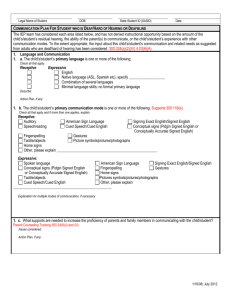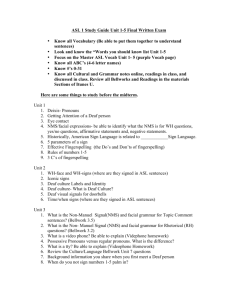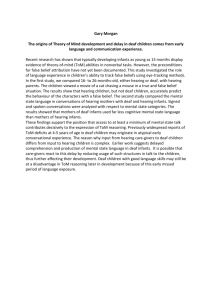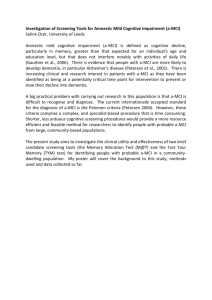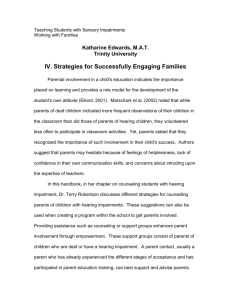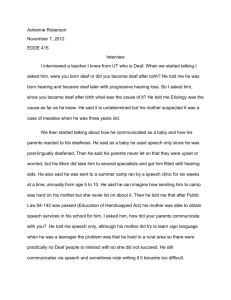Parent Handout: Communication Strategies
advertisement
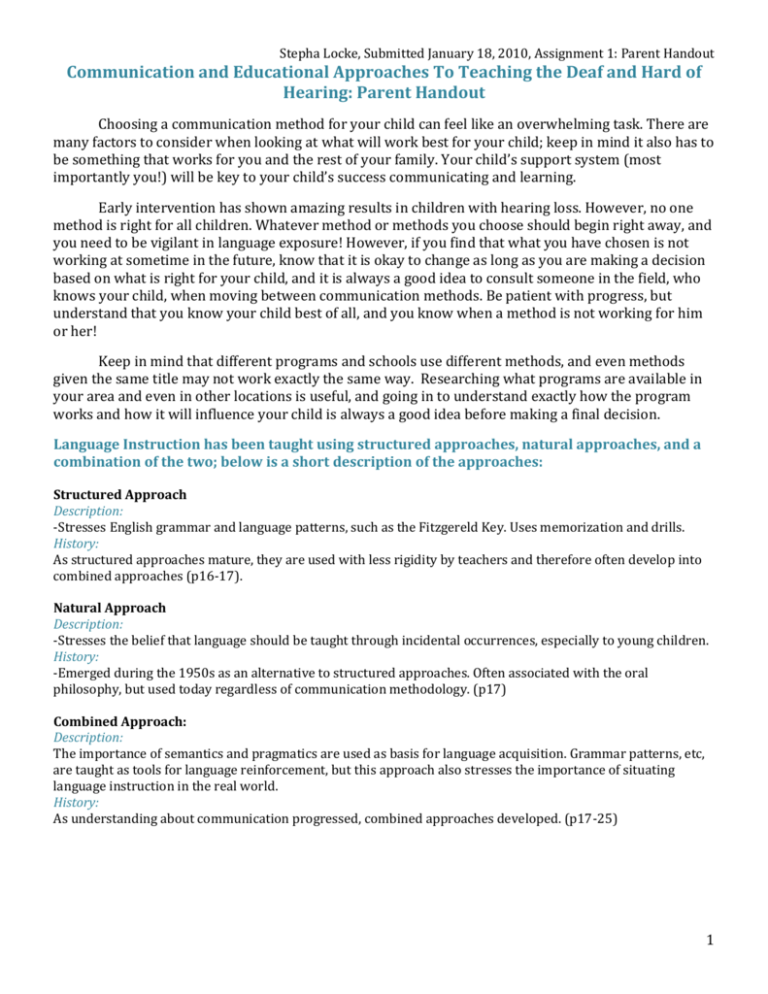
Stepha Locke, Submitted January 18, 2010, Assignment 1: Parent Handout Communication and Educational Approaches To Teaching the Deaf and Hard of Hearing: Parent Handout Choosing a communication method for your child can feel like an overwhelming task. There are many factors to consider when looking at what will work best for your child; keep in mind it also has to be something that works for you and the rest of your family. Your child’s support system (most importantly you!) will be key to your child’s success communicating and learning. Early intervention has shown amazing results in children with hearing loss. However, no one method is right for all children. Whatever method or methods you choose should begin right away, and you need to be vigilant in language exposure! However, if you find that what you have chosen is not working at sometime in the future, know that it is okay to change as long as you are making a decision based on what is right for your child, and it is always a good idea to consult someone in the field, who knows your child, when moving between communication methods. Be patient with progress, but understand that you know your child best of all, and you know when a method is not working for him or her! Keep in mind that different programs and schools use different methods, and even methods given the same title may not work exactly the same way. Researching what programs are available in your area and even in other locations is useful, and going in to understand exactly how the program works and how it will influence your child is always a good idea before making a final decision. Language Instruction has been taught using structured approaches, natural approaches, and a combination of the two; below is a short description of the approaches: Structured Approach Description: -Stresses English grammar and language patterns, such as the Fitzgereld Key. Uses memorization and drills. History: As structured approaches mature, they are used with less rigidity by teachers and therefore often develop into combined approaches (p16-17). Natural Approach Description: -Stresses the belief that language should be taught through incidental occurrences, especially to young children. History: -Emerged during the 1950s as an alternative to structured approaches. Often associated with the oral philosophy, but used today regardless of communication methodology. (p17) Combined Approach: Description: The importance of semantics and pragmatics are used as basis for language acquisition. Grammar patterns, etc, are taught as tools for language reinforcement, but this approach also stresses the importance of situating language instruction in the real world. History: As understanding about communication progressed, combined approaches developed. (p17-25) 1 Stepha Locke, Submitted January 18, 2010, Assignment 1: Parent Handout Information about various communication methods: Cued Speech Description: Handshapes are used by the mouth to assist with speech; these handshapes are not sign nor are they fingerspelling, instead they are shapes to phonetically code spoken language, as many sounds are indistinguishable when speech reading. This method seems to benefit only those with usable residual hearing and good speech reading skills, and can work successfully for those who are able to encode language phonetically through the auditory pathway. (Easterbrooks and Baker, p13) History: Originally developed by Cornett in the 1960s. More Info: Check out http://www.cuedspeech.org/ English Based Sign Systems: Total Communication (TC) Seeing Essential English (SEE I) & Signing Exact Description: English (SEE II) TC consists of auditory training, speech reading, Description: fingerspelling, speech, and sign language (not ASL, but These systems borrow signs from ASL and put them in coded English- see English Based Sign Systems.) English grammatical order, creating signs and systems History: for pronouns, prefixes, etc, as necessary. ASL signs are Also made popular in the 1970s, TC was developed by altered by initializing when used in such systems. Roy Holocomb in 1967, who believed Oralism was too Coded English systems cannot represent a complete restrictive. Holocomb’s version used ASL, but because language system by themselves, so another choice is teachers use sign and speech together (sim com), preferable for profoundly deaf children who rely coded English became the norm. TC was the most solely on visuals to access information. (p13-15) widely used method in the USA from the late 1970s to History: the 1990s. (p13-15) English based sign systems developed popularity in More Info: the 1970s. Some developers avoided fingerspelling Check out: http://www.ericdigests.org/1998because of a belief that it would be too difficult for 2/total.htm young children. BC Family Hearing Resource Centre: http://www.bcfamilyhearing.com Bilingual-Bicultural (Bi-Bi) Auditory Verbal Therapy Description: Description: Bi-Bi uses ASL as the first language of the child, and Students are dissuaded from using their vision to help English as a second (written) language. It uses the their listening, and instead are taught to use their premise that deaf children learn more effectively auditory channel only. Similar to the Oral method but through their unimpaired visual pathways than their without the visual cues. The idea is to promote an impaired auditory channel. individual’s ability to self monitor spoken language by Bi-Bi includes recognition of Deaf culture as well. listening to themselves and others. History: History: Appeared in the 80s due to dissatisfaction with the A form or aural rehabilitation similar to the outcomes of deaf education. Research indicates that Acoupedics approach by Pollack (1964): a child taught deaf children born to deaf parents who used ASL to lipread or sign will rely on their visuals and may not produced better results in academic achievement, develop their full listening potential. This has become literacy, English usage, and social emotional an appropriate approach given the developments in development. (p15). technology, primarily the cochlear implant. More Info: More Info: Check out: http://www.ericdigests.org/1998Check out: 2/children.htm http://nc.agbell.org/netcommunity/academy/ Provincial School for the Deaf: Children’s Hearing and Speech Centre of BC: http://sd41.bc.ca/programs/school_for_the_deaf.htm http://www.deafeducationcentre.org/ 2 Reference: Stepha Locke, Submitted January 18, 2010, Assignment 1: Parent Handout Easterbrooks, S. R. & Baker, S. (2002). Language learning in children who are deaf and hard of hearing: Multiple pathways. (pp. 13-22). Boston, MA: Allyn & Bacon. Additional Reference: Bell, L., Lane, S., & Parson-Tylka, T. (2006). My turn to learn: An up to date guide for parents of babies and children with hearing loss. Surrey, BC: BC Family Hearing Resource Centre. 3

